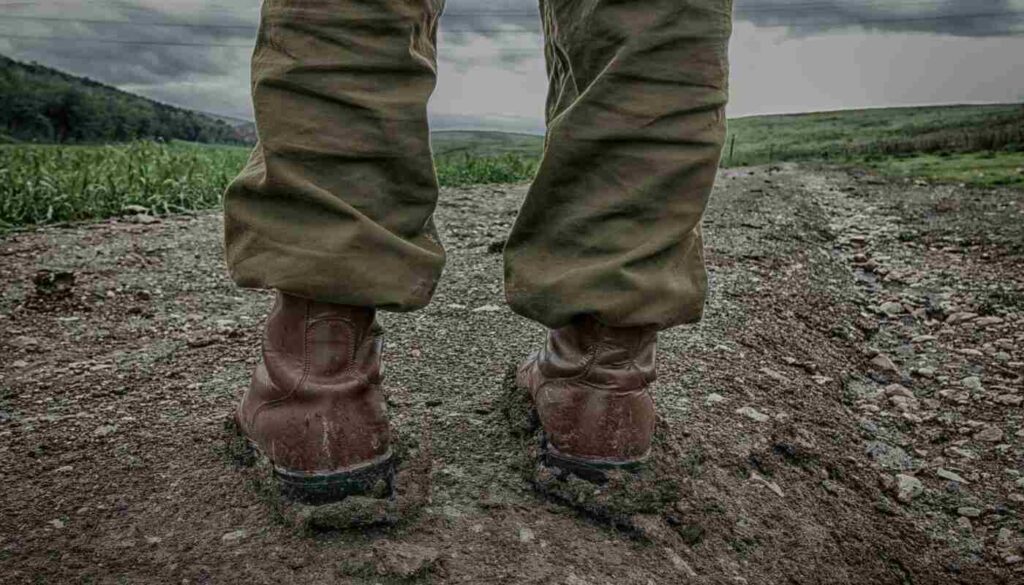Hiking is a form of outdoor event, it involves walking for some time in a specific area. However, hikers are expected to wear some protection since their routes most of the time are places they have never been to. Some of this protection includes a jacket, hat and boots.
A hiker’s boots have to be the most important, they have to be strong and durable.
Let’s dig in
Are Hiking Boots Slip Resistant?
When choosing hiking boots, make sure the ones you are considering are slip-resistant. You may encounter dangerous objects on the trail that could cause serious injury if you slip and fall, so it is very important to find a boot that gives you the stability you need.
Hiking shoes prevent slipping compared to other types of shoes. There is a deep grip level at the bottom to help the user get a firm grip on the surface they are walking or climbing.
Special grooves and patterns are set into the sole to add stability not normally available with regular boots.
What Makes Hiking Boots Slip Resistant?
Certain factors make hiking boots slip-resistant hiking boots. Firstly, you can check if your hiking boots are non-slip by checking with the manufacturer. This is something that will be found on the package box or somewhere inside the boot. However, there is a possibility that the shoe will display a non-slip logo on the outside of the boots as well.
Secondly, The other way to know if your hiking boots are slip-resistant is to look at the sole on the bottom. A slip-resistant boot will have designs or patterns woven into the sole that help prevent slips and falls. These patterns are going to work towards moving liquids out from under the shoe, and some are done in such a way that they will clean themselves out while you are hiking or walking.
However, if your hiking boot is not slip-resistant, there are several ways to make it slip-resistant
- Use a mixture of salt and gum. Making non-slip shoes is about changing the way shoes communicate with slippery elements. You can change this by coating the soles of your shoes with a mixture of rubber glue and salt. Simply apply the glue to your soles and sprinkle salt on top.
- Apply sand. You can use sand the same as rubber and salt mixture. Just mix the sand with adhesive and apply it to the soles of the boots.
- Spray the soles with hairspray: If you want to quickly fix your shoes, you can try spraying the sole of your shoes with hair spray. This solution won’t work for a long time, it is a short-time fix. You should also apply hair spray daily.
- Score the bottom: The easiest way to turn your shoes and boots into slip-resistant is to take a knife and cut a few steps to step on them. The lines let the water flow as you walk.
- Brush the soles: you may want to add more traction to your tires. You can do this by rubbing them down to sand the bottom with concrete, gravel or even sandpaper.
How Can I Choose a Slip Resistant Hiking Boot?
Whether it’s a simple day trip or a long backpacking trip, functional, comfortable and reliable hiking boots are a must. Functional boots are so good that you can’t feel the performance.
What are the most important factors when choosing hiking boots? Proper fit is probably the most important aspect of hiking boots. The shoes should fit your feet. Regardless of how it works on paper, a correct or incorrect fit can take advantage of or break your entire experience.
The main features of the boot include comfort, function, safety, support and cushioning. In addition, the most important features of hiking boots are excellent traction, shock absorption, water resistance, breathability, excellent foot and/or ankle support, stability, and lightweight and durable weight. Choosing a slip-resistant boot is very easy, you just have to look for some pointer.
Here are some guides in choosing the right slip-resistant boots:
- Multipurpose soles: These types of soles can walk on rocky areas, they also have strong grips in steep and slippery areas
- Soles for moderate terrain: These types have deeper soles for places that have gravel or stones.
- Soles for steep and slippery terrain: They are perfect for walking in slippery places. They also can be used in climbing trees and rocks.
- Soles with grip on rocks: As it suggests, it has a firm grip on rocks.
What Are The Differences Between Non-Slip and Slip-resistant Boots?

Non-slip boots are designed to keep your feet dry and comfortable in wet or icy conditions. They usually have a rubber sole that helps distribute weight evenly, preventing slips and falls.
Slip-resistant boots are meant for more rugged environments; they often have a harder heel and toe than non-slip boots, as well as rough textures on the soles that help absorb shocks when you walk or run across uneven surfaces.
What Are The Importance of Slip-Resistant Boots?
- Slip-resistant footwear is the type of boots that guarantee a person’s safety by preventing them from slipping and falling. These boots are important for those who work in hazardous environments, as they help to avoid injuries. slip-resistant footwear uses special materials and construction to ensure that the boots stay on the feet no matter how much or how little the person moves. This is important for workers who are required to move around a lot, as it allows them to stay safe and avoid injuries.
- Slip-resistant boots are also important for maintaining an individual’s safety on slippery surfaces. If a person is slipping and falls, they will lose their balance and may fall to their death. By using slip-resistant boots, a person can stay safe and avoid injuries, maintain their balance, and stay on slippery surfaces.
- Slip-resistant boots are both types of boots that are important for avoiding injuries and staying safe. In hazardous environments, they help to avoid injuries and stay on their feet. They are also important for maintaining an individual’s safety on slippery surfaces.
Conclusion
Resistance to slipping is said to be the amount of energy applied against the shoe or foot’s natural tendency to slide down a walkway’s surface. To determine whether footwear has good slip resistance or not, consider the soles of the shoes as well as whether or not there are any foreign materials between them.
It is important to have the best hiking boots for your hikes. These boots can protect you from the hazardous and unexpected things you run into on the trail. The best thing you can do is buy a good pair of non-slip hiking boots.
I hope this article has given you a clear idea of if hiking boots are slip-resistant.

